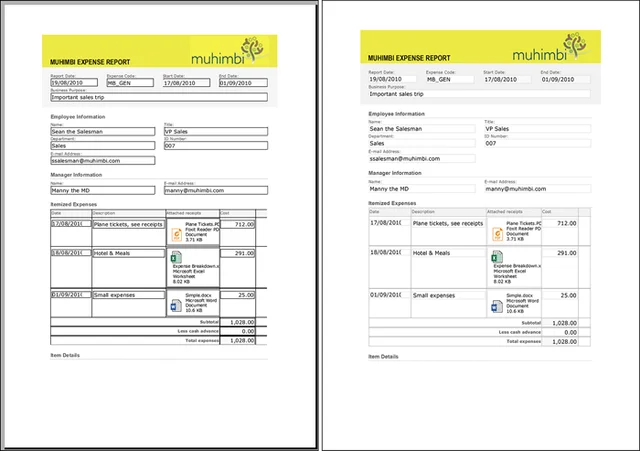We like to throw in a wildcard every once in a while, functionality that no-one has asked for, but we think our customers will really like. This tends to work out very well, for example the time we decided to provide a lot of flexibility around copying of SharePoint meta-data. Another one of those crazy wild-cards was support for the conversion of InfoPath forms to PDF, XLS, HTML and DOC. InfoPath is pretty obscure, right? Microsoft has even retired it, who needs a converter, who even cares? EVERYONE! A surprising number of people want to convert and archive InfoPath files, and for great reasons as well.
Over the years we have added many popular facilities to the InfoPath converter including the ability to convert InfoPath attachments and the ability to dynamically control which InfoPath view to use for PDF conversion. There was only one problem though, as Microsoft stopped caring about InfoPath, they slowly but surely crippled its PDF output abilities. It all started with the introduction of Internet Explorer 9 and was made worse with the introduction of Windows Server 2012 and InfoPath 2013. Out of the box, and completely unrelated to our software, InfoPath doesn’t even include content of checkboxes in a PDF, and that is just one of the smaller problems.
Our support desk is always happy to assist those customers who, for reasons beyond their control, cannot downgrade Internet Explorer or switch Windows versions. More often than not this resulted in solutions that worked well enough, but…. ughhh… horrible hacks, loads of support hours wasted, non-intuitive solutions, this has to stop…. and, as of today, it has!
Version 8.0 of the PDF Converter for SharePoint, PDF Converter Services (for Java, C#, PHP, Ruby) as well as our PDF Converter for SharePoint Online comes with a brand new InfoPath converter. It still supports all the cool features of the previous converter, but the generated PDF files look much, MUCH, better, they basically look identical to what comes out of the printer.
The key improvements are:
- ‘Printer like’ output.
- Images & logos are displayed in high resolution.
- Border colors and thickness are correct.
- ‘Phantom’ grey borders are a thing of the past.
- Page size can be controlled in detail.
- Page orientation can be controlled in detail.
The last 2 options are particular important for forms that have been designed with SharePoint’s Forms Services in mind. Although those forms are created in InfoPath as well, and can be converted using our software just fine, these forms typically don’t specify a page size or orientation. The new PDF Converter automatically picks up these settings when they ARE defined in the form, but when the information is missing it will try to substitute it. These settings can be overridden globally or at the individual conversion level.

Although the default values suffice for most situations, the following entries can be controlled via the conversion service’s configuration file. For details about how to edit this file see this article..
- InfoPathConverterFullFidelity.UseNativePrintEngine: This setting controls which InfoPath converter is used, the legacy one (false) or the new high-fidelity one (true). This setting is automatically populated with the option selected during installation.
- InfoPathConverterFullFidelity.DefaultPaperSize: The output paper size to use for InfoPath views without a specified printer / paper size. This does not change the paper size for views where that information IS specified. Leave this setting empty to take the value from the default printer or specify a named format such as 'A4' or 'Letter' ( Full list of accepted paper sizes )). PLEASE NOTE THAT THIS VALUE IS CASE SENSITIVE.
- InfoPathConverterFullFidelity.ForcePaperSize: Force the paper size, regardless of the printer / paper size being present in the definition of the InfoPath view.
- InfoPathConverterFullFidelity.DefaultPageOrientation: The Page orientation for InfoPath views that don't explicitly specify a printer / paper size. Either 'Portrait' or 'Landscape'. Leave empty to let InfoPath decide.
- InfoPathConverterFullFidelity.ForcePageOrientation: Force the page orientation regardless of the printer / paper size being present in the definition of the InfoPath view
The easiest way to enable the new InfoPath converter is to do so during the setup process, for details see this blog post.
In order to use the new InfoPath converter on 64 bit systems, please install the 64 bit version of Office / InfoPath. 32 bit Windows versions work fine with the 32 bit version of Office / InfoPath.
If you are still on Windows Server 2003 then we don’t judge you, but you will need to contact our support desk to request assistance with the deployment of the new InfoPath converter as after 12 years… well… things have moved on a bit.
Any questions or feedback? Leave a comment below or contact us, we love talking to our customers.
Labels: Articles, InfoPath, News, pdf, PDF Converter, PDF Converter Services

